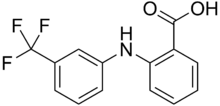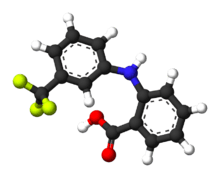Flufenamic acid
Flufenamic acid (FFA) is a member of the anthranilic acid derivatives (or fenamate) class of NSAID drugs[1]:718 Like other members of the class, it is a COX inhibitor and prevents formation of prostaglandins.[2] FFA is known to bind to and reduce the activity of prostaglandin F synthase and activate TRPC6.[3]
 | |
 | |
| Clinical data | |
|---|---|
| AHFS/Drugs.com | International Drug Names |
| Routes of administration | oral, topical |
| ATC code | |
| Legal status | |
| Legal status |
|
| Pharmacokinetic data | |
| Protein binding | extensively |
| Metabolism | Hydroxylation, glucuronidation |
| Elimination half-life | ~3 h |
| Excretion | 50% urine, 36% feces |
| Identifiers | |
IUPAC name
| |
| CAS Number |
|
| PubChem CID | |
| IUPHAR/BPS | |
| DrugBank |
|
| ChemSpider |
|
| UNII | |
| KEGG |
|
| ChEBI | |
| ChEMBL | |
| CompTox Dashboard (EPA) | |
| ECHA InfoCard | 100.007.723 |
| Chemical and physical data | |
| Formula | C14H10F3NO2 |
| Molar mass | 281.22991 g/mol g·mol−1 |
| 3D model (JSmol) | |
| Melting point | 124 to 125 °C (255 to 257 °F) resolidification and remelting at 134°C to 136°C |
| Solubility in water | Practically insoluble in water; soluble in ethanol, chloroform and diethyl ether mg/mL (20 °C) |
SMILES
| |
InChI
| |
| (verify) | |
It is not widely used in humans as it has a high rate (30-60%) of gastrointestinal side effects.[4]:310 It is generally not available in the US.[2] It is available in some Asian and European countries as a generic.[5]
Scientists led by Claude Winder from Parke-Davis invented FFA in 1963, along with fellow members of the class, mefenamic acid in 1961 and meclofenamate sodium in 1964.[1]:718
References
- Whitehouse M. Drugs to Treat Inflammation: A Historical Overview. pp 707-729 in Frontiers in Medicinal Chemistry, Volume 4. Eds Rahman A, et al. Bentham Science Publishers, 2009 ISBN 9781608052073
- NIH LiverTox Database Mefenamic Acid Last updated June 23, 2015. Page accessed July 3, 2015. Quote: "(fenamates generally not available in the United States, such as tolfenamic acid and flufenamic acid)"
- "Chemical–Gene Interaction Query: Flufenamic Acid (Homo sapiens)". Comparative Toxicogenomics Database. North Carolina State University. Retrieved 4 July 2015.
- Jeffrey K. Aronson. Meyler's Side Effects of Analgesics and Anti-inflammatory Drugs. Elsevier, 2009 ISBN 9780080932941
- Drugs.com Drugs.com international listings for flufenamic acid Page accessed July 3, 2015
| Pyrazolones / Pyrazolidines | |
|---|---|
| Salicylates | |
| Acetic acid derivatives and related substances | |
| Oxicams | |
| Propionic acid derivatives (profens) |
|
| N-Arylanthranilic acids (fenamates) | |
| Coxibs | |
| Other |
|
Items listed in bold indicate initially developed compounds of specific groups. #WHO-EM †Withdrawn drugs. ‡Veterinary use medications. | |
| |||||||||||||||||||||||||||||||||||||||||||||||||||||||||||||||||||||||||||||||||||||||||||||||||
This article is issued from
Wikipedia.
The text is licensed under Creative
Commons - Attribution - Sharealike.
Additional terms may apply for the media files.